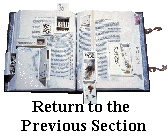Science and the Artist's Book
An exhibition by the Smithsonian Institution Libraries and
the Washington Project for the Arts
Astronomy
 Herald of Science
Herald of Science
 Download full-size JPEG (252K) or GIF (227K) image.
Download full-size JPEG (252K) or GIF (227K) image.
Christiaan Huygens
Systema Saturnium [The Saturnian system]
The Hague, Netherlands, 1659
The 17th-century Dutch astronomer Huygens discovered one of
the moons of Saturn through a telescope that he built himself.
His observations led him to theorize that the planet Saturn was
surrounded by a ring, then only dimly visible through the
telescopes of the period. Huygens' illustration shows the ring
that encircles the planet.
 Artist's Book
Artist's Book
 Download full-size JPEG (231K) or GIF (134K) image.
Download full-size JPEG (231K) or GIF (134K) image.
Timothy C. Ely
Saturnia
Portland, Oregon, 1994
[wood, handmade paper, aluminum]
Timothy Ely compares Huygens' exploration of outer space to
his own efforts at probing "inner space"--the depths of his
fertile imagination. Within the reaches of this internal
universe, Ely finds the visions that he translates into paintings
for his books. To add an extraterrestrial element to his work,
the artist has mixed particles of metal oxide into the cover
materials. These came from the dust of a meteor found in
Argentina in 1576.
 Herald of Science
Herald of Science
 Download full-size JPEG (301K) or GIF (169K) image.
Download full-size JPEG (301K) or GIF (169K) image.
Johannes Hevelius
Machinae Coelestis Pars Prior [The celestial machine: The first part]
Danzig, Poland, 1673-1679
Hevelius, an expert builder of his own "celestial machines," constructed telescopes ranging in size up to 50 meters (150 feet) in length. Yet for charting the position of stars and planets, he trusted more in his own eyesight than in the accuracy of telescopes.
 Artist's Book
Artist's Book
 Download full-size JPEG (127K) or GIF (95K) image.
Download full-size JPEG (127K) or GIF (95K) image.
David Horton
Celestial Wondering
New Milford, New York: Flying Pyramid Press, 1994
[wood, metal, book board, photographs, electronic and fiber-optic
elements]
Artist David Horton is fascinated by Hevelius' early
telescope. He comments, "While the mammoth astronomical telescope
was a scientific tool, it also could be thought of as a totem to
the heavens and a vehicle for imaginary travel."
 Herald of Science
Herald of Science
 Download full-size JPEG (207K) or GIF (145K) image.
Download full-size JPEG (207K) or GIF (145K) image.
Tycho Brahe
Epistolarum Astronomicarum Libri [Collected letters on astronomy]
Uraniborg, Denmark, 1596
In the late 1500s, the Danish astronomer Tycho Brahe suggested
a new model for the universe, in which the Sun circled the Earth
while the other planets circled the Sun. Brahe's careful
observations eventually helped to confirm the theory that the
Earth revolved around the Sun. Shown here is Brahe's famous
astronomical observatory and home, Uraniborg ["Heavenly Castle"],
located on an island off the coast of Denmark.
 Artist's Book
Artist's Book
 Download full-size JPEG (227K) or GIF (133K) image.
Download full-size JPEG (227K) or GIF (133K) image.
Geoffrey Hendricks
QUADRANT / A Meditation on Tycho Brahe
New York, New York, 1994
[wood, brass, watercolor, ceramic, glass, stainless steel, stone, cloth, museum board]
Geoffrey Hendricks' book is like a game with puzzle pieces.
Its elements invite the viewer to contemplate the sky and the
workings of the universe as Brahe did, and to reflect on the way
our senses perceive the world. Hendricks' interest in Tycho Brahe
is heightened by his own Scandinavian ancestry.
 Herald of Science
Herald of Science
 Download full-size JPEG (526K) or GIF (190K) image.
Download full-size JPEG (526K) or GIF (190K) image.
Roberte Recorde
The Castle of Knowledge, Containing the Explication of the
Sphere Bothe Celestiall and Materiall
London, 1556
Recorde's textbook is written as a dialogue between teacher
and student. This technique enables the reader to proceed step by
step through the basic principles of the ancient system of
astronomy, in which the Sun and planets were thought to revolve
around the Earth. Recorde is known as the founder of the English
school of mathematical writers.
 Artist's Book
Artist's Book
 Download full-size JPEG (218K) or GIF (143K) image.
Download full-size JPEG (218K) or GIF (143K) image.
Katherine Ng
A Hypothetical Analysis of the Twinkle in Stars (as told by a
child to a teacher)
Los Angeles, California, 1994
[paste paper and letterpress]
Katherine Ng employs the dialogue format used by Recorde but
reverses the roles of the speakers. In her book, the child is the
"teacher" who analyzes the stars, and the adult is the "student."
The book itself takes the form of a nearly-completed "wishing
star." Gentle pressure on each side of the folded paper pentagon
would produce a three-dimensional five-pointed star.


 Herald of Science
Herald of Science
 Download full-size JPEG (252K) or GIF (227K) image.
Download full-size JPEG (252K) or GIF (227K) image.
 Artist's Book
Artist's Book
 Download full-size JPEG (231K) or GIF (134K) image.
Download full-size JPEG (231K) or GIF (134K) image.
 Herald of Science
Herald of Science
 Download full-size JPEG (301K) or GIF (169K) image.
Download full-size JPEG (301K) or GIF (169K) image.
 Artist's Book
Artist's Book
 Download full-size JPEG (127K) or GIF (95K) image.
Download full-size JPEG (127K) or GIF (95K) image.
 Herald of Science
Herald of Science
 Download full-size JPEG (207K) or GIF (145K) image.
Download full-size JPEG (207K) or GIF (145K) image.
 Artist's Book
Artist's Book
 Download full-size JPEG (227K) or GIF (133K) image.
Download full-size JPEG (227K) or GIF (133K) image.
 Herald of Science
Herald of Science
 Download full-size JPEG (526K) or GIF (190K) image.
Download full-size JPEG (526K) or GIF (190K) image.
 Artist's Book
Artist's Book
 Download full-size JPEG (218K) or GIF (143K) image.
Download full-size JPEG (218K) or GIF (143K) image.

